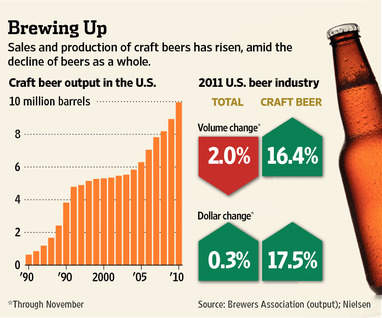
I should confess right up front that I’ve never been a big fan of Martha Stewart. I’m not really sure why, but her advice and how she presents it has always bugged me for some reason. I guess for me, it always comes across as trying to be for everyone, the common people, but can really only be followed by people with a lot of free time and money. Even my wife disagrees with me on this one, so I have to conclude it’s just a weird personal prejudice I have about her.
So Stewart was on the Today show this morning in a segment entitled “Bottoms Up! Martha throws a beer party.” And yes, I know it’s great whenever craft beer gets attention from the mainstream media, but the curmudgeon in me just can’t let it pass uncritically. Here’s how it went down.
Matt Lauer begins the segment by saying that “forget the college keg, beer has grown up. Now it’s all about pairing some cold brew with great snacks.” So those are the two choices of what beer can be, “college keg” or “grown-up?” I know it was just an off-hand remark, but sheesh. And being “grown-up” means pairing it with snacks? It just seems like they could do so much better if they really cared about it.
So in comes Martha Stewart, beer savvy housekeeping diva, and declares “a beer tasting party is like the new thing.” That statement reminds me of the actor or musician who finally has a big hit after toiling in his or her craft for thirty years and is suddenly hailed as an overnight success. For millions of people, beer tasting has been a pretty big deal for quite some time now, but now that it’s reached Martha’s notice it’s “the new thing.”
But before she goes too crazy, Lauer reigns her in, suggesting that she “keep it casual, it doesn’t have to be fancy.” Naturally, you should keep it casual, because it would be absurd to suggest otherwise. Stewart, who usually seems at ease in front of the camera, looked unsure of herself talking about the beer, and even appeared to skirt any questions about it.
After showing off the chalkboard oilcloth table cloth where people can use chalk so they “can write their impressions of the beer” right on the table, Lauer asks her what beers are on the table, and guesses, “light, dark and amber.” Stewart replies “yes,” explaining that it’s because “each have a very specific kind of quality.”
When they moved over to the food, she perked up and appeared much more comfortable and at ease. Her demeanor seemed far more confident, since she was now in her element. But the weird thing is, the food seemed much more fancy, with onion jam made with balsamic vinegar and maple syrup and cocktail meatballs with three kinds of meat. That’s not “keeping it casual” to me. So in keeping things “casual” because it’s beer, the food doesn’t stay casual? That seems weird to me. Beer can’t be fancy, but food almost has to be.
In the four and a half minute piece, no more than a minute was about the beer, and in the end, they never got any more specific about the beers than “light, dark and amber,” and that much only because Matt Lauer asked. No mention of what styles. No mention of what brands, though Greg Koch tweeted that he’d been told the dark beer was Stone Smoked Porter. Maybe they didn’t need to talk about specific brands, but to not even discuss what kinds of beers they were tasting seemed odd, especially since the whole point was supposedly to tell people how to throw “a beer party.” They never adressed how or why any of the food paired with the beer, apart from an offhand remark Martha made that the parsnip chips paired with the dark beer’s “smokey flavors.” In the end, it was really all about the food, and really very little, if anything, was communicated about the beer. Which, if you think about it, is pretty pathetic if, as they’re claiming, “a beer tasting party is like the new thing.” Like, for sure. And I guess it must be; after all I saw Martha Stewart say so on national TV.
Visit msnbc.com for breaking news, world news, and news about the economy









